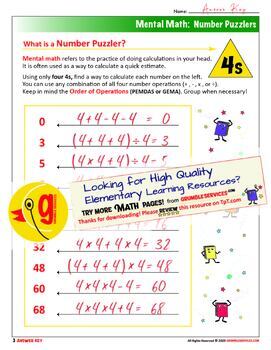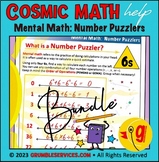Mental Math Number Puzzlers: 2-3-4-5s - Number Operations & Order of Operations
- PDF
What educators are saying
Also included in
- Mental Math Number Puzzlers BUNDLE: Number Operations & Order of Operations PEMDAS GEMA - Multiplication and Division, Addition and Subtraction - Montessori-inspired printable SEMiPRO Math help (8 pages + key): These fun, quick exercises are designed to provide math practice to emerging studentsPrice $6.75Original Price $7.50Save $0.75
Description
Mental Math Number Puzzlers: 2-3-4-5s - Number Operations & Order of Operations PEMDAS GEMA - Multiplication and Division, Addition and Subtraction - Montessori-inspired printable ROOKIE Math help (4 pages + key):
These fun, quick exercises are designed to provide math practice to emerging students, encourage those students not confident in their mental math abilities or who are hesitant to learn their facts.
What are Number Puzzlers? Using only four of each number (i.e. 5, 5, 5, 5), find a way to calculate each number. You can use any combination of all four number operations. Keep in mind the Order of Operations (PEMDAS or GEMA) and group when necessary!
Do you like the Mental Math Number Puzzlers: 2-3-4-5s - Number Operations & Order of Operations pages? Please consider other EXTRA MATH HELP learning resources from Grumble!
Number Puzzlers: 6-7-8-9s - Number Operations & Order of Operations
Mental Math Practice & Number Sense: Rounding Rules for 10s & 100s - Math pages
Order of Operations: PEMDAS, GEMS & GEMA - Pre-Algebra & Mental Math
Looking for High Quality, Professionally Designed Elementary Learning Resources? Look no further - FOLLOW GRUMBLE! Although the word Montessori is in the title, ANY type of elementary student will benefit from independent, self-directed learning.
As stated in the Teachers Pay Teachers refund policy, “all sales on TpT of digital resources are considered final and nonrefundable.” Please ask any questions you have about this product before purchasing. Thank you! © 2020-2024 Grumble Services, LLC • All rights reserved.
Dr. Maria Montessori believed the only way our world would find lasting peace was through educating our children. Much of her elementary curriculum was written by her during a period of internment in India during WWII. This time period helped solidify Dr. Montessori’s belief in Peace Education.
Resource Color Guide (just like the Montessori hierarchical colors):
ROOKIE Pages (Green) - Aimed toward early to mid level elementary students.
SEMiPRO Pages (Blue) - Aimed toward mid level elementary students.
VETERAN Pages (Red) - Aimed toward mid to late level elementary students.
But of course, you know the child best, so adjust accordingly.
In the words of Dr. Montessori, "Follow the Child!"






